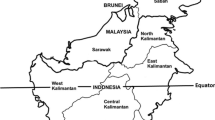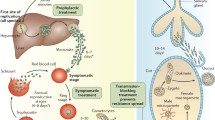Abstract
The recent spread of malaria in the Usambara Mountains in Tanzania has been blamed on climatic changes experienced during the 20th century. Here we suggest that recent changes in the pattern of malaria does not result so much from these changes as from changes in the use and efficacy of antimalarial drugs. The recent resurgence of malaria in this area corresponds with the rapid evolution of parasite strains resistant to chloroquine. The ineffectiveness of anti-malarial drugs may have left the people of the Usambaras at the same high risk of infection as they were before the introduction of modern medicine.
Similar content being viewed by others
References
Snow, R.W., Craig, M.H., Deichmann, U. & Le Sueur, D. A preliminary continental map for malaria mortality among African children. Parasitology Today 1999; 15: 99-104.
Lindsay, S.W. & Martens, W.J.M. Malaria in the African highlands: past, present and future. Bulletin of the World Health Organization 1998; 76: 33-45.
Matson, A.T. The history of malaria in the Nandi. East African Medical Journal 1957; 34: 431-41.
Khaemba, B.M., Mutani, A. & Bett, M.K. Studies of anopheline mosquitoes transmitting malaria in a newly developed highland urban area: A case study of Moi University and its environs. East African Medical Journal 1994; 71: 159-64.
Garnham, P.C.C. The incidence of malaria at high altitudes. Journal of the National Malaria Society 1948; 7: 275-84.
Shanks, G.D., Biomndo, K., Hay, S.I. & Snow, R.W. Changing patterns of clinical malaria since 1965 among a tea estate population located in the Kenyan highlands. Transactions of the Royal Society of Tropical Medicine and Hygiene 2000; 94: 253-55.
Steyn, J.J. The effect on the anopheline fauna of cultivation of swamps in Kigezi district, Uganda. East African Medical Journal 1946; 23: 163-69.
Loevinsohn, M.E. Climatic warming and increased malaria incidence in Rwanda. The Lancet 1994; 343: 714-18.
Lepers, J.P., Deloron, P., Fontenille, D. & Coulanges, P. Reappearance of falciparum malaria in central highland plateau of Madagascar. The Lancet 1988, 586.
Matola, Y.G., White, G.B. & Magayuka, S.A. The changed pattern of malaria endemicity and transmission at Amani in the eastern Usambara Mountains, north-eastern Tanzania. Journal of Tropical Medicine and Hygiene 1987; 90: 127-34.
Mouchet, J., Manguin, S., Sircoulon, J., Laventure, S., Faye, O., Onapa, A.W., Carnevale, P., Julves, J. & Fontenille, D. Evolution of malaria in Africa for the past 40 years: Impact of climatic and human factors. Journal of the American Mosquito Control Association 1998; 14: 121-30.
Lepers, J.P., Deloron, M.D., Andriamagatiana-Rason, J.A., Ramanamirija & Coulanges, P. Newly transmitted Plasmodium falciparum malaria in the central highland plateaux of Madagascar: Assessment of clinical impact in a rural community. Bulletin of the World Health Organization 1990; 68: 217-22.
Hulme, M., Doherty, R., Ngara, T., New, M. & Lister, D. African climate change: 1900-2100. Climate Research in press.
Hamilton, A.C. & Mwasha, I.V. History of resource utilization and management. In: Hamilton A.C. and Bensted-Smith R. Forest conservation in the East Usambara Mountains Tanzania. IUCN 1989: 45-56
Feierman, S. The Shambaa Kingdom. University of Wisconsin Press, 1974.
Koch, R. Report on West Usambara from the point of view of health (5/8/1898). Tanganyika Notes and Records 1953; 35: 7-13.
Taute, M. Ärztliches aus dem kriege in Ostafrica 1914-1918. Schriftleitung des Archivs, Institut für Schiffs und Tropenkrankenheiten 1919; 23: 523-54.
Bø dker, R. Variation in the malaria risk in the Usambara Mountains, Tanzania. Ph.D. thesis, University of Copenhagen, 2000.
Clyde, D.F. Malaria in Tanzania. London: Oxford University Press, 1967.
Lindblade, K., Walker, E.D., Onapa, A.W., Katunga, J. & Wilson, M.L. Highland malaria in Uganda: prospective analysis of an epidemic associated with El Ninõ . Transactions of the Royal Society of Tropical Medicine and Hygiene 1999; 93:480-87
Pringle, G. The effect of social factors in reducing the intensity of malaria transmission in coastal east Africa. Transactions of the Royal Society of Tropical Medicine and Hygiene 1966, 60: 549-53.
Ellman, R., Maxwell, C.A., Finch, R. & Shayo, D. Malaria and anaemia at different altitudes in the Muheza district of Tanzania: childhood morbidity in relation to level of exposure to infection. Annals of Tropical Medicine and Parasitology 1998; 92: 741-753.
Wilson, D.B. & Wilson, M.E. The manifestations and measurement of immunity to malaria in different races. Transactions of the Royal Society of Tropical Medicine and Hygiene 1937; 30: 431-48.
Hamilton, A.C. Climatic change on the East Usambaras, statements on climatic and environmental change. In: Hamilton A.C. and Bensted-Smith R. Forest conservation in the East Usambara Mountains Tanzania. IUCN 1989: 115-16
Binggeli, P. The ecology of Maesopsis invasion and dynamics of the evergreen forest of the East Usambaras, and their implications for forest conservation and forestry practices. In: Hamilton A.C. and Bensted-Smith R. Forest conservation in the East Usambara Mountains Tanzania. IUCN 1989: 269-300
Bruen, M. Climatic change on the East Usambaras. In: Hamilton A.C. and Bensted-Smith R. Forest conservation in the East Usambara Mountains Tanzania. IUCN 1989: 109-14
Hamilton, A.C. Climatic change on the East Usambaras. In: Hamilton A.C. and Bensted-Smith R. Forest conservation in the East Usambara Mountains Tanzania. IUCN 1989: 103-8
Freeman, T. & Bradley, M. Temperature is predictive of severe malaria years in Zimbabwe. Transactions of the Royal Society of Tropical Medicine and Hygiene 1996; 90: 232.
Lindsay, S.W. & Birley, M.H. Climate change and malaria transmission. Annals of Tropical Medicine and Parasitology 1996; 90: 573-88.
Moreau, R.E. A synecological study of Usambara, Tanganyika territory, with particular reference to birds. Journal of Ecology 1935; 23: 143.
Lindsay, S.W., Bø dker, R., Malima, R., Msangeni, H.A. and Kisinza, W. Effect of 1997-98 El Ninõ on highland malaria in Tanzania, The Lancet; 2000 355: 989-90.
Lundgren, L. & Lundgren, B. Rainfall, interception and evaporation in the Mazumbai forest reserve, West Usambara Mts., Tanzania and their importance in the assessment of land potential. Geografi ska Annaler 1979; 61 A: 157-78.
Pereira, F.R.S. Land use and water resources in temperate and tropical climates, Cambridge University Press, 1973
Pocs, T. A preliminary study of the undergrowth of primary and secondary submontane rainforests in the East Usambara Mountains, with notes on epiphytes. In: Hamilton A.C. and Bensted-Smith R. Forest conservation in the East Usambara Mountains Tanzania. IUCN 1989: 301-6
Schmidt, P.R. Early exploitation and settlement in the Usambara Mountains. In: Hamilton A.C. and Bensted-Smith R. Forest conservation in the East Usambara Mountains Tanzania. IUCN 1989: 75-8
Farler, J.P. The Usambara country in East Africa. Proceedings of the Royal Geographical Society 1879; 1: 81-97.
Fleuret, A. (1980). Nonfood uses of plants in Usambara. Economic Botany, 34: 320-33.
Rodgers, W.A. & Homewood, K.M. Species richness and endemism in the Usambara mountain forests, Tanzania. Biological Journal of the Linnean Society 1982; 18: 197-242.
Hamilton, A.C and Bensted-Smith R. Forest conservation in the East Usambara Mountains Tanzania, IUCN, 1989.
Moreau, R.E. Some eco-climatic data for closed evergreen forest in tropical Africa. Journal of the Linnean Society of Zoology 1935; 39: 285-93.
Pocs, T. Bioclimatic studies in the Uluguru Mountains I. Acta Botanica Hungarica 1974; 20: 115-35.
Clyde, D.F., Webbe, G. & Shute, G.T. Single dose pyrimethamine treatmentof Africans during a malaria epidemic in Tanganyika. East African Medical Journal 1956; 35: 23-29.
Fleuret, P. & Fleuret, A. Nutritional implications of stable food crop successions in Usambara, Tanzania. Human Ecology 1980; 8: 311-27.
Heijnen, J.D. National policy, foreign aid and rural development (Lushoto District, Tanzania). Bulletin Geographic Institute Rijksuniversiteit Utrecht 1974; 2: 1-165.
Attems, M. (1968). Permanent cropping in the Usambara Mts. In: Rutherberg, H. Smallholder farming and smallholder development in Tanzania. Münich: Weltforum Verlag, 1968: 137-74
Clyde, D.F. & Shute, G.T. Resistance of East African varieties of Plasmodium falciparum to Pyrimethamine. Transactions of the Royal Society of Tropical Medicine and Hygiene 1954; 48: 495-500.
Otieno, L.H., Lelijveld, J.L.M., Meuwissen, J., Verbeek, A.M.J.A. & Doesburg, A.M.J.A. Serological studies of malaria in East Africa (I). Tropical and Geographical Medicine 1971; 23: 369-75.
Voller, A., Lelijveld, J.L.M. & Matola, Y.G. Immunoglobulin and malarial indices at different a ltitudes in Tanzania. Journal of Tropical Medicine and Hygiene 1971; 74: 45-52.
Lelijveld, J.L.M., Otieno, L.H. & Meuwissen, J. Serological studies of malaria in East Africa. Tropical and Geographical Medicine 1973; 25: 75-83.
Fendall, N.R.E. & Grounds, J.G. The incidence and epidemiology of disease in Kenya. Journal of Tropical Medicine and Hygiene 1965; 68: 134-41.
Brinkmann, U. & Brinkmann, A. Malaria and health in Africa: the present situation and epidemiological trends. Tropical Medicine and Parasitology 1991, 42: 204-13.
Kihamia, C.M. & Gill, H.S. Chloroquine-resistant falciparum malaria in semi-immunenative African Tanzanians. The Lancet 1982; 11: 43-43. Resurgence of malaria in the Usambara mountains
Fowler Jr, V.G., Lemnge, M.M., Irare, S.G.M., Malecela, E., Mhina, J., Mtui, S., Mashaka, M. & Mtoi, R. Efficacy of chloroquine on Plasmodium falciparum transmitted at Amani, Eastern Usambara Mountains, North-east Tanzania: an area where malaria has recently become endemic. Journal of Tropical Medicine and Hygiene 1993; 96: 337-45.
Warsame, M., Kilimali, V.A.E.B., Wernsdorfer, W.H., Lebbad, M., Rutta, A.S. & Ericsson, Ö. Resistance to chloroquine and sulfadoxine-pyrimethamine in Plasmosium falciparum in Muheza district, Tanzania. Transactions of the Royal Society of Tropical Medicine and Hygiene 1999; 93: 312-3.
Lines, J., Wilkes, T.J. & Lyimo, E. Human malaria infectiousness measured by age-specifi c sporozoite rates in Anopheles gambiae in Tanzania. Parasitology 1991; 102: 167-77.
Draper, C.C., Hill, M., Kilimali, V.A.E.B. & Brubaker, G. Serial studies of the evolution of drug resistance in malaria in an area of East Africa: fi ndings from 1979 up to 1986. Journal of Tropical Medicine and Hygiene 1988; 91: 265-273.
Tarimo, S.A. Malaria infection among school children in Muheza area. In: East African Institute of Malaria and Vector-borne Diseases Annual Report 1973: 179-91
Gupta, S. & Snow, R.W. How do bednets influence the transmissibility of Plasmodium falciparum? Parasitology Today 1996; 12: 89-90.
Alilio, M.S. Health services at the district level in Tanzania service through-put and resources levels: The gap between expectations and performance. University of Copenhagen. Thesis/Dissertation, 1999.
Greenberg, A.E., Ntumbanzondo, N., Ntula, N., Mawa, L., Howell, J. & Davachi, F. Hospital-based surveillance of malaria-related paediatric morbidity and mortality in Kinshasa, Zaire. Bulletin of the World Health Organization 1989; 67: 189-96.
Trape, J.F., Pison, G., Preziosi, M.P., Enel, C., Degrées du Loû , A., Delaunay, V. Samb, B., Lagarde, E., Molez, J.F. & Simondon, F. Impact of chloroquine resistance on malaria mortality. Comptes Rendus de l'Académie des Sciences, Paris 1998; 321: 689-97.
Moreau, R.E. A contribution to tropical African bird-ecology. Journal of Animal Ecology 1934; 3: 41-69.
Hamilton, A.C. The climate of the East Usambaras. In: Hamilton A.C. and Bensted-Smith R. Forest conservation in the East Usambara Mountains Tanzania. IUCN 1989: 97-102
Lundgren, L. Comparison of surface runoff and soil loss from runoff plots in forest and small-scale agriculture in the Usambara Mts., Tanzania. Geografi ska Annaler 1980; 62A: 113-48.
Clyde, D.F. & Msangi, A.S. Malaria distribution in Tanganyika (Part II). East African Medical Journal 1963; 40: 71-82.
Bagster Wilson, D. & Wilson, M.E. Rural hyperendemic malaria in Tanganyika territory: Part II. Transactions of the Royal Society of Tropical Medicine and Hygiene 1962; 56: 287-93.
Clyde, D.F. A study of mononuclear leucocyte and neutrophil patterns among east Africans partially immune to malaria. Journal of Tropical Medicine and Hygiene 1964; 67: 25-30.
Pringle, G. & Avery-Jones, S. An assessment of the sporozoite inoculation rate as a measure of malaria transmission in the Ubembe area of north-east Tanzania. Journal of Tropical Medicine and Hygiene 1966; 69: 132-39.
Wilson, D.B. Report of the Malaria Unit, Tanga, 1933-34. 1936
Magayuka, S.A. & Muniss, J.N. The incidence of malaria transmission in Amani. In: East African Institute of Malaria and Vector-borne Diseases Annual Report 1973: p 77-9
Author information
Authors and Affiliations
Rights and permissions
About this article
Cite this article
Bødker, R., Kisinza, W., Malima, R. et al. Resurgence of Malaria in the Usambara Mountains, Tanzania, An Epidemic of Drug-Resistant Parasites. Global Change & Human Health 1, 134–153 (2000). https://doi.org/10.1023/A:1010077105257
Issue Date:
DOI: https://doi.org/10.1023/A:1010077105257




